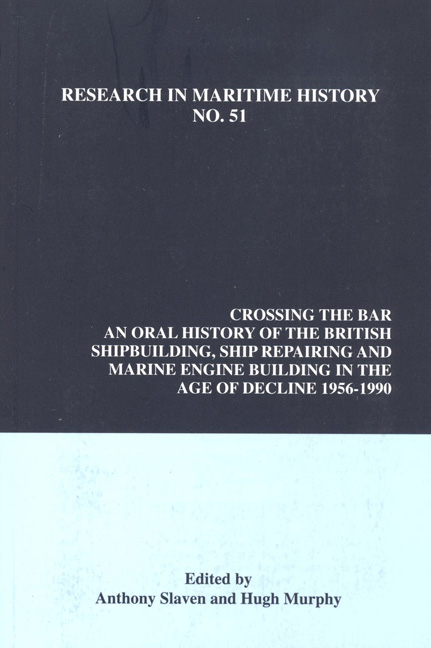 Crossing the Bar
Crossing the Bar Book contents
- Frontmatter
- Contents
- About the Authors
- Dedication
- Preface: A Shipbuilding Libretto
- Introduction
- Interviews
- Lower Clyde
- Upper Clyde
- The Tyne
- The Wear
- Barrow-in-Furness
- The South Coast
- The Humber
- Belfast
- British Shipbuilding Industry Officials
- The Trade Unions
- The Civil Servants, Board of Trade, Shipbuilding Enquiry Committee, Shipbuilding Industry Board, Ministry of Technology, Department of Trade and Industry, Department of Industry
- The Politicians
- 45 Tony Benn, Minister of Technology, Secretary of State for Industry/ Energy
- 46 Norman Tebbitt, Secretary of State for Trade and Industry
- 47 Teddy Taylor, MP, Scottish Office Minister for Industry
- 48 Bob Clay, M.P, Sunderland North British Shipbuilders Plc
- Interviews British Shipbuilders Plc
- Conclusion
- Select Bibliography
48 - Bob Clay, M.P, Sunderland North British Shipbuilders Plc
from The Politicians
- Frontmatter
- Contents
- About the Authors
- Dedication
- Preface: A Shipbuilding Libretto
- Introduction
- Interviews
- Lower Clyde
- Upper Clyde
- The Tyne
- The Wear
- Barrow-in-Furness
- The South Coast
- The Humber
- Belfast
- British Shipbuilding Industry Officials
- The Trade Unions
- The Civil Servants, Board of Trade, Shipbuilding Enquiry Committee, Shipbuilding Industry Board, Ministry of Technology, Department of Trade and Industry, Department of Industry
- The Politicians
- 45 Tony Benn, Minister of Technology, Secretary of State for Industry/ Energy
- 46 Norman Tebbitt, Secretary of State for Trade and Industry
- 47 Teddy Taylor, MP, Scottish Office Minister for Industry
- 48 Bob Clay, M.P, Sunderland North British Shipbuilders Plc
- Interviews British Shipbuilders Plc
- Conclusion
- Select Bibliography
Summary
I became involved with the shipbuilding industry when I became the MP for Sunderland North in 1983. At that time there were a number of shipyards in my constituency, which at a later period became re-grouped under the heading of North East Shipbuilders Limited. Sunderland was still one of the principal UK merchant shipbuilding centres and one of the main sources of employment in my constituency. I have simply been a constituency MP who has acted as a spokesman for the industry and the workforce during the period of its rundown in Sunderland, and nationally.
The period in which I was involved was when the Conservative Government privatised the warship yards and some mixed yards. It was a period in which many people argued that this would be the beginning of the end, that you could not separate the warship yards from the merchant yards. That was proved a correct analysis. With hindsight, the real cutting edge of that argument was not so much that it was totally wrong thing to do, but that corporate separation might have had logic to it provided that there was a clear policy for merchant shipbuilding. The problem was that there was not. So the industry internationally was going through an appalling period, and the UK merchant yards just closed year in year out, one after the other.
With the advent of Lord Young as Secretary of State and Kenneth Clarke as Minister of State at the Department of Trade and Industry it is quite clear that a decision was made in late 1987 to write of merchant shipbuilding. Shipbuilding was in such a state and the market was in such a state that it could not conceivably be profitable. I think that they then went through this guise of saying that if people want to buy it they can. If they do not want to buy it, it will close, knowing perfectly well that most of it would close. Govan got the Chinese ships deal, which made the yard suitable for privatisation. Then the Government got through the Kvaerner deal [a Norwegian shipbuilding conglomerate which at that point could not access European Intervention Fund monies, but could after its purchase of Govan] to buy Govan.
- Type
- Chapter
- Information
- Crossing the BarAn Oral History of the British Shipbuilding, Ship Repairing and Marine Engine-Building Industries in the Age of Decline, 1956-1990, pp. 191 - 192Publisher: Liverpool University PressPrint publication year: 2013
